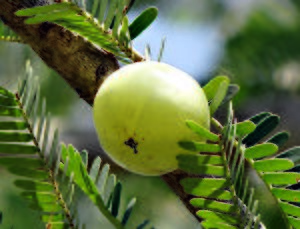Note: This is a project under development. The articles on this wiki are just being initiated and broadly incomplete. You can Help creating new pages.
Difference between revisions of "Phyllanthus emblica - Emblic, Amalaki"
| Line 19: | Line 19: | ||
*Amalaki is beneficial in heart attack, fast heartbeat and high blood presure. | *Amalaki is beneficial in heart attack, fast heartbeat and high blood presure. | ||
| − | *If you have headache or migraine then take one amla murabba | + | *If you have headache or migraine then take one amla murabba everyday with empty stomach. |
| − | |||
*It helps to maintain the natural sheen of the hair. | *It helps to maintain the natural sheen of the hair. | ||
*indian gooseberry makes your immune system and nervous system stronger. | *indian gooseberry makes your immune system and nervous system stronger. | ||
Revision as of 16:21, 22 March 2018
Nelli Subbi Phyllanthus emblica [1] The tree is small to medium in size, reaching 1–8 m (3 ft 3 in–26 ft 3 in) in height. The branchlets aren't glabrous or finely pubescent, 10–20 cm (3.9–7.9 in) long, usually deciduous; the leaves are simple, subsessile and closely set along branchlets, light green, resembling pinnate leaves. The flowers are greenish-yellow. The fruit is nearly spherical, light greenish yellow, quite smooth and hard on appearance, with six vertical stripes or furrows.
In traditional medicine, dried and fresh fruits of the plant are used. All parts of the plant are used in various Ayurvedic/Unani medicine (Jawarish amla) herbal preparations, including the fruit, seed, leaves, root, bark and flowers. According to Ayurveda, amla fruit is sour (amla) and astringent (kashaya) in taste (rasa), with sweet (madhura), bitter (tikta) and pungent (katu) secondary tastes (anurasas). Its qualities (gunas) are light (laghu) and dry (ruksha), the postdigestive effect (vipaka) is sweet (madhura) and its energy (virya) is cooling (shita). According to Ayurveda, amla balances all three doshas. While amla is unusual in that it contains five out of the six tastes recognized by Ayurveda, it is most important to recognize the effects of the "virya", or potency, and "vipaka", or post-digestive effect. Considered in this light, amla is particularly helpful in reducing pitta because of its cooling energy. It also balances both Pitta and vata by virtue of its sweet taste. The kapha is balanced primarily due to its drying action. It may be used as a rasayana (rejuvenative) to promote longevity, and traditionally to enhance digestion (dipanapachana), treat constipation (anuloma), reduce fever (jvaraghna), purify the blood (raktaprasadana), reduce cough (kasahara), alleviate asthma (svasahara), strengthen the heart (hrdaya), benefit the eyes (chakshushya), stimulate hair growth (romasanjana), enliven the body (jivaniya), and enhance intellect (medhya).
In Ayurvedic polyherbal formulations, Indian gooseberry is a common constituent, and most notably is the primary ingredient in an ancient herbal rasayana called Chyawanprash [2]. This formula, which contains 43 herbal ingredients as well as clarified butter, sesame oil, sugar cane juice, and honey, was first mentioned in the Charaka Samhita as a premier rejuvenative compound.
In Chinese traditional therapy, this fruit is called yuganzi (余甘子), which is used to treat throat inflammation.
Common name
- English - Emblic
- Kannada - ಬೆಟ್ಟದ ನೆಲ್ಲಿಕಾಯಿ
- Hindi - आँवला
Benefits
- Amalaki is beneficial in heart attack, fast heartbeat and high blood presure.
- If you have headache or migraine then take one amla murabba everyday with empty stomach.
- It helps to maintain the natural sheen of the hair.
- indian gooseberry makes your immune system and nervous system stronger.
